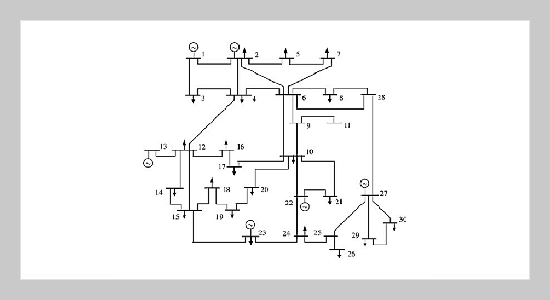- [1] H. Li, T. Zheng, S. Huang, Z. Tang, and H. Cao, (2020) “A fault ride through strategy of unified power flow controller and its coordination with protection" Elec�tric Power Systems Research 184: 106323. DOI: 10.1016/j.epsr.2020.106323.
- [2] G. Wu, P. Ju, X. Song, C. Xie, and W. Zhong, (2016) “Interaction and coordination among nuclear power plants, power grids and their protection systems" Energies 9: 306. DOI: 10.3390/en9040306.
- [3] M. Amin and B. Wollenberg, (2005) “Toward A Smart Grid,„IEEE Power & Energy Magazine”" Toward a SmartGrid-IEEE power and Energy Magazine, September/October2005:
- [4] H. Khalilnezhad, M. Popov, L. van der Sluis, J. A. Bos, J. P. W. de Jong, and A. Ametani, (2017) “Coun�termeasures of zero-missing phenomenon in (E) HV cable systems" IEEE Transactions on power delivery 33: 1657–1667.
- [5] A. Askarzadeh, (2016) “Capacitor placement in distribu�tion systems for power loss reduction and voltage improve�ment: a new methodology" IET Generation, Transmis�sion & Distribution 10: 3631–3638.
- [6] M. Montazeri and A. Askarzadeh, (2019) “Capacitor placement in radial distribution networks based on identi�fication of high potential busses" International Transac�tions on Electrical Energy Systems 29: e2754.
- [7] Z. Zhou and L. Ge, (2019) “Operation of stand-alone mi�crogrids considering the load following of biomass power plants and the power curtailment control optimization of wind turbines" IEEE Access 7: 186115–186125.
- [8] H.-J. Kim, H.-S. Lee, S.-W. Lee, D.-H. Jung, and D.-S. Moon. “Mitigation of environmental impact of power-plant discharge by use of Ocean Thermal Energy Conversion system”. In: IEEE, 2010, 1–4.
- [9] A. Mazandarani, T. M. I. Mahlia, W. T. Chong, and M. Moghavvemi, (2011) “Fuel consumption and emis�sion prediction by Iranian power plants until 2025" Re�newable and Sustainable Energy Reviews 15: 1575–1592.
- [10] R. Billinton, S. Kumar, N. Chowdhury, K. Chu, L. Goel, E. Khan, P. Kos, G. Nourbakhsh, and J. Oteng�Adjei, (1990) “A reliability test system for educational purposes-basic results" IEEE Transactions on Power Systems 5: 319–325.
- [11] M. Fan, K. Sun, D. Lane, W. Gu, Z. Li, and F. Zhang, (2018) “A novel generation rescheduling algorithm to im�prove power system reliability with high renewable energy penetration" IEEE Transactions on Power Systems 33: 3349–3357.
- [12] I. de J Silva, M. J. Rider, R. Romero, A. V. Garcia, and C. A. Murari, (2005) “Transmission network expansion planning with security constraints" IEE Proceedings�Generation, Transmission and Distribution 152: 828–836.
- [13] S. D. L. Torre, A. J. Conejo, and J. Contreras, (2008) “Transmission expansion planning in electricity markets" IEEE transactions on power systems 23: 238–248. DOI: 10.1109/TPWRS.2007.913717.
- [14] S. Mohseni, A. C. Brent, and D. Burmester, (2019) “A demand response-centred approach to the long-term equip�ment capacity planning of grid-independent micro-grids optimized by the moth-flame optimization algorithm" En�ergy Conversion and Management 200: 112105.
- [15] Y. M. Alsmadi, A. M. Abdel-hamed, A. E. Ellissy, A. S. El-Wakeel, A. Y. Abdelaziz, V. Utkin, and A. A. Uppal, (2019) “Optimal configuration and energy man�agement scheme of an isolated micro-grid using Cuckoo search optimization algorithm" Journal of the Franklin Institute 356: 4191–4214.
- [16] Z. Movahediyan and A. Askarzadeh, (2018) “Multi�objective optimization framework of a photovoltaic-diesel generator hybrid energy system considering operating reserve" Sustainable Cities and Society 41: 1–12.
- [17] M. Farrokhabadi, C. A. Cañizares, and K. Bhat�tacharya, (2015) “Frequency control in isolated/islanded microgrids through voltage regulation" IEEE Transac�tions on Smart Grid 8: 1185–1194.
- [18] M. Farrokhabadi, C. A. Cañizares, and K. Bhat�tacharya, (2016) “Unit commitment for isolated micro�grids considering frequency control" IEEE Transactions on Smart Grid 9: 3270–3280.
- [19] A. Ahmad and J. Y. Khan, (2018) “Roof-top stand-alone PV micro-grid: A joint real-time BES management, load scheduling and energy procurement from a peaker genera�tor" IEEE Transactions on Smart Grid 10: 3895–3909. DOI: 10.1109/TSG.2018.2842757.
- [20] N. Zhao, X. Yu, K. Hou, X. Liu, Y. Mu, H. Jia, H. Wang, and H. Wang, (2021) “Full-time scale resilience enhancement framework for power transmission system under ice disasters" International Journal of Electrical Power & Energy Systems 126: 106609.
- [21] N. L. Dehghani, A. B. Jeddi, and A. Shafieezadeh, (2021) “Intelligent hurricane resilience enhancement of power distribution systems via deep reinforcement learn�ing" Applied energy 285: 116355.
- [22] M. Mahzarnia, M. P. Moghaddam, P. Siano, and M.-R. Haghifam, (2020) “A comprehensive assessment of power system resilience to a hurricane using a two-stage an�alytical approach incorporating risk-based index" Sus�tainable Energy Technologies and Assessments 42: 100831.
- [23] J. Najafi, A. Peiravi, and J. M. Guerrero, (2018) “Power distribution system improvement planning under hurri�canes based on a new resilience index" Sustainable cities and society 39: 592–604.
- [24] H. Rasay, F. Naderkhani, and A. M. Golmohammadi, (2020) “Designing variable sampling plans based on life�time performance index under failure censoring reliability tests" Quality Engineering 32: 354–370. DOI: 10.1080/08982112.2020.1754426.
- [25] L. Tang, J. Qu, Z. Mi, X. Bo, X. Chang, L. D. Anadon, S. Wang, X. Xue, S. Li, and X. Wang, (2019) “Substantial emission reductions from Chinese power plants after the introduction of ultra-low emissions standards" Nature Energy 4: 929–938. DOI: 10.1038/s41560-019-0468-1.
- [26] R. J. Campbell and S. Lowry. “Weather-related power outages and electric system resiliency”. In: Congres�sional Research Service, Library of Congress Wash�ington, DC, 2012.
- [27] S. Dorahaki, A. Abdollahi, M. Rashidinejad, and M. Moghbeli, (2021) “The role of energy storage and demand response as energy democracy policies in the energy pro�ductivity of hybrid hub system considering social incon�venience cost" Journal of Energy Storage 33: 102022. DOI: 10.1016/j.est.2020.102022.
- [28] E. Kiani, H. Doagou-Mojarrad, and H. Razmi, (2020) “Multi-objective optimal power flow considering voltage stability index and emergency demand response program" Electrical Engineering 102: 2493–2508. DOI: 10.1007/s00202-020-01051-1.
- [29] A. Alghazi, S. Z. Selim, and A. Elazouni, (2012) “Per�formance of shuffled frog-leaping algorithm in finance�based scheduling" Journal of computing in civil engi�neering 26: 396–408. DOI: 10.1061/(ASCE)CP.1943-5487.0000157.
- [30] M. Eusuff, K. Lansey, and F. Pasha, (2006) “Shuffled frog-leaping algorithm: a memetic meta-heuristic for dis�crete optimization" Engineering optimization 38: 129– 154. DOI: 10.1080/03052150500384759.
- [31] M. Shahidehpour and Y. Wang, (2003) “Appendix C: IEEE30 bus system data":
















